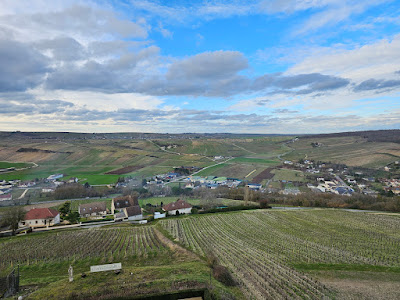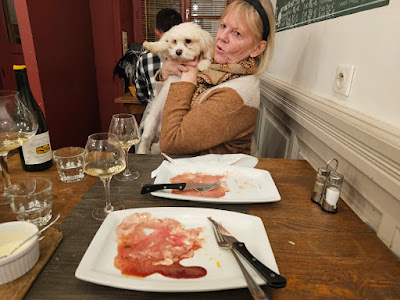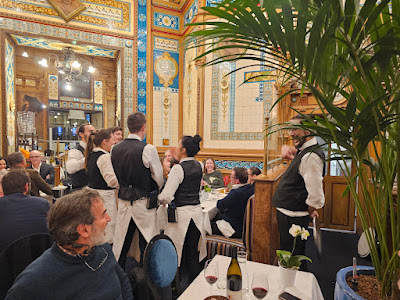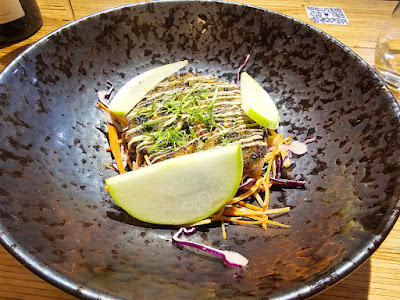Pictures: Moon - Monks - Michelin: Overnight stay and 1-star Michelin Dinner at the Abbaye Royale de Fontevraud, with Chef Thibaut Ruggeri (February 2024)
The Loire Valley is not only a paradise for castle buffs and wine enthusiasts, but also .... for cheese lovers.
On the 2024 Loire Valley by ombiasy WineTours in June 2024, we will indeed spend lots of time visiting castles and wineries. Towards the end of the tour, when we are for 2 nights in Sancerre, we
will also devote some time to cheese, more specifically, to the iconic Crottin de Chavignol goat cheese.
In France, cheese is made everywere. As for the Loire valley, the western part towards the coast, cow milk cheese rules, while in the eastern part of the Loire Valley goat cheese dominates.
In fact, it is the various kinds of goat cheese that people think of when it comes to cheese in the Loire valley. We will focus on one of them, the Crottin de Chavignol, when we spend 2 nights in Sancerre, a stone's throw awy from Chavignol, and visit a winemaker in Chavignol as well as have a cheese-centered lunch in Chavignol at a well-known cheese producer, Romain Dubois in Chavignol. Fromagerie Romain Dubois is a leading producer of Crottin de Chavignal, with 2 outlets, one in Saint-Satur and one in Chavignol. In Chavignol, in additon to the cheese store, Romain Dubois has a wine and cheese bar, where we will have lunch and taste Romain Dubois' Crottin de Chavignol at different stages of ripeness.
See: Announcement: Loire Valley 2024 by ombiasy WineTours (Sunday, June 09 - Thursday June 20, 2024)
France is Home of some of the most beleoved Cheeses in the World
“How can you be expected to rule a country that has over 200 kinds of cheese?” – Charles de Gaulle
“Any country with 300 kinds of cheese cannot die” – Winston Churchill
“A meal without cheese is a beautiful girl that lacks an eye” – Brillat-Savarin (who shares the name of a French cheese as well)
Stickymangorice.com: To say that the French nation loves cheese is an understatement. France is the home to some of the most beloved cheeses in the world, and their names are legendary – Rochefort, Brie, Camembert, Comté. While opinion differs about how many varieties of cheese there are in France, there are at least 400 (with some estimates ranging to over 1000)!
French cheese differs greatly depending on the region in which it is produced, the source of the milk, the history of the region, and local traditions. Many French cheeses have attained the certification known as AOC (appellation d’origine contrôlée), guaranteeing authenticity for the origin and production of a cheese (in the same way that champagne is only produced in the Champagne region).
While in the western part of the Loire Valley, cow milk cheese rules, in the eastern part of the Loire Valley goat cheese dominates.
Cow Milk Cheese in the Western Part of the Loire Valley - the Pays de la Loire
Stickymangorice.com: Stretching from the Atlantic coast, through to the lower part of the Loire Valley, Pays de la Loire is known for its grand châteaux, its Breton culture of the Brittany Peninsula, and fine Loire Valley wines. Cows milk cheeses are the specialty here.
Tomme de Chouans cheese comes from the Vendee department, a soft and chewy cow’s milk cheese. It is known for its stripey yellow rind and mild taste. Another popular cow’s milk cheese familiar to many is Port Salut, with an orange rind, semi-soft texture, and creamy and mild taste. Curé Nantais is a supple and sticky cheese with a characteristic smoky flavour, and is commonly eaten with fruit. One of the more unique cheeses of the region is Embruns aux Algues, a 1-month aged cheese mixed with seaweed, giving a strong and salty taste.
Goat Milk Cheese in the Eastern Part of the Loire Valley - Centr-Val de Loire
Stickymangorice.com: Centre-Val de Loire is the region just south of Paris, a region of wide open green spaces that follows its main river, the Loire. It is best known for its spectacular Loire Valley châteaux, home to French kings, queens, and nobility for centuries. The region is best known for its goat cheese, and 6 varieties have attained AOC status.
The unpasteurized soft goat cheese Sainte-Maure-de-Touraine is perhaps the most well-known cheese of the region. The cheese is shaped as a log, with a distinctive grey mould rind, rolled in ash, traditionally with a length of straw running through its centre. Another unpasteurized goats cheese local to the region is Selles-sur-Cher, a wheel of soft cheese with a strong taste and a blue-grey rind. Another goat cheese is Valençay, which is formed in distinctive pyramid shapes. Some cows’ milk cheeses are produced here too, such as Olivet Cendré, a soft cheese with delicate and salty taste, and a grey ash-coloured rind.
streetdirectory.com: The Loire Valley offers goat's cheese lovers a paradise. It is a
perfect location for a holiday meandering beside the Loire River,
visiting famous historic chateaux, cheese producers and caves for wine
tasting and even staying in a boutique chateau hotel if you chose. This
region is justly called the Garden of France, and is sprinkled with
amazing Renaissance castles open to the public and an abundance of fine
wines and cheeses. Chateau du Guerinet near Blois is a perfect base for
a cheese lover's Loire Valley holiday.The Loire Valley is the
starting point in the history of goat's-milk cheese in France. In the
8th Century, the Saracens of Arab descent were repelled at Poitiers.
When they were expelled from France they left behind their goats and the
recipes for making incredible cheese from goats milk.
The
quaint villages on either side of the Loire River produce goat's cheeses
of different sizes and shapes. There are six AOC (Appellation
d'Origine Controlee) cheeses: Sainte-Maure de Touraine, Selles-sur-Cher,
Valencay, Pouligny-Saint-Pierre, Chabichou du Poitou and Crottin de
Chavignol. There are currently 42 French cheeses with AOC status. An
AOC label indicates quality and guarantees that a product has been made
within a specified region of France following established methods of
production.
Valencay cheese looks like a small black pyramid.
It is purported that the shape of the cheese was originally a perfect
pyramid. But when Napoleon returned from a disastrous campaign in Egypt
he stopped at Valencay Castle, the cheese reminded him of the Egyptian
pyramids and in a furry he chopped of the top of the cheese with his
sword. The Valencay goat's cheese has a rind of natural mould, covered
with salted powdered charcoal and goes nicely with a glass of Quincy,
Reuilly or Sancerre.
Sainte-Maure de Touraine is a blue-grey
mould covered long truncated log of goat's cheese. The cheese is
mature, balanced, round with salt, sourness and an aroma of walnut.
This cheese is produced all year long and is nicely complimented by a
glass of Chinon or Vouvray.
Selles-sur-Cher also has a rind of
natural mould covered with powdered and salted charcoal. The pate is
hard at first, then moist, heavy and clay-like as it blends and melts in
the mouth. The taste is slightly sour and salty with a touch of
sweetness. A glass of Sancerre or Pouilly Fume accompanies this cheese
beautifully.
Pouligny-Saint-Pierre nicknamed the Eiffel Tower
or Pyramid because if its shape. The rind is of natural mould. The
pate is a soft moist white and crumbly. The taste is at first sour and
salty followed by sweetness. This cheese goes wonderfully with a glass
of Reuilly or Sancerre.
Chabichou du Poitou has a thin rind of
white, yellow or blue mould and a delicate slightly sweet flavour.
Pouilly Fume and Sancerre wines go nicely with this cheese.
Crottin
de Chavignol known as Chavignol is hard black and knobbly on the
surface, and the taste is a balance of sourness, sweetness and a little
salt to be enjoyed with a glass of Sancerre de Chavignol.
Cheese and "Affinage"
In France, in the cheese world, les vedettes…the rock stars…are not usually the actual dairy farmers, and cheese producers…(though good French gourmands are aware of them, too).
No. The real stars are the ones who receive the cheese from producers, then hold it in their shops, downstairs in the cave, until the cheeses are just á point (perfectly ready to eat). The cheeses may hold in that window of perfection for as little as a day, sometimes a few days. A great affineur knows exactly when to sell it to you…will not sell it too early, will not sell it too late.
But there's more than mere timing involved. A great affineur truly "raises" his or her cheeses as if they were children. Some days, if the cheeses are too moist, they must be dried with a towel; some days, if they're too dry, they must be moistened. Most days they need to be turned, or shifted in the cellar; some of them need a wash on a regular basis with strong alcohol to develop a certain flavor in the rind. There is no specific list of what the affineur must do in his her or cave; are there any rules for parents? Affinage, and parenting, are creative activities!
See: Announcement: Loire Valley 2024 by ombiasy WineTours (Sunday, June 09 - Thursday June 20, 2024)

































No comments:
Post a Comment